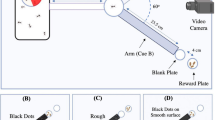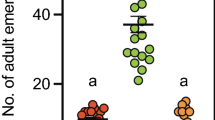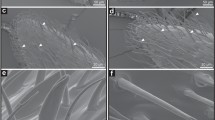Abstract
Parasitic insects use chemical cues to locate their hosts, and prior experiences can modify their responses to these odours1–4. Females of the parasitic wasp Microplitis croceipes experienced by contact with host faeces, orient and fly upwind to odours from their hosts, larvae of the moth Heliothis zea5. We use flight tunnel studies to show that associative learning occurs during encounters with host faeces. When females touch the faeces with their antennae they learn to recognize and subsequently fly to various volatile odours, even novel and otherwise unattractive odours like vanilla, associated with the faeces. They link these volatile odours with a water extractable nonvolatile chemical in the faeces, evidently a host-specific recognition cue. The association of tracking cues with host by-products, without the need for direct contact with the host, is a valuable adaptation for locating cryptic and evasive hosts.
This is a preview of subscription content, access via your institution
Access options
Subscribe to this journal
Receive 51 print issues and online access
$199.00 per year
only $3.90 per issue
Buy this article
- Purchase on Springer Link
- Instant access to full article PDF
Prices may be subject to local taxes which are calculated during checkout
Similar content being viewed by others
References
Arthur, A. P. in Semiochemicals, Their Role in Pest Control (eds Nordlund, D. A., Jones, R. L. & Lewis, W. J.) 97–120 (Wiley, New York, 1981).
Vet, L. E. M. Neth. J. Zool. 33, 225–248 (1983).
Vet, L. E. M. & van Opzeeland, K. Oecologia 63, 171–177 (1984).
Vet, L. E. M. & van Opzeeland, K. Neth. J. Zool. 35, 497–504 (1985).
Drost, Y. C., Lewis, W. J., Zanen, P. O. & Keller, M. A. J. chem. Ecol. 12, 1247–1262 (1986).
Palmerino, C. C., Rusiniak, K. W. & Garcia, J. Science 208, 753–755 (1980).
Nordlund, D. A. in Semiochemicals, Their Role in Pest Control (eds Nordlund, D. A., Jones, R. L. & Lewis, W. J.) 13–28 (Wiley, New York, 1981).
Jones, R. L., Lewis, W. J., Bowman, M. C., Beroza, M. & Bierl, B. A. Science 173, 842–843 (1971).
Papaj, D. R. Anim. Behav. 34, 1281–1288 (1986).
Papaj, D. R. & Prokopy, R. J. J. chem. Ecol. 12, 1125–1143 (1986).
Traynier, R. M. M. Physiol. Entomol. 9, 465–472 (1984).
Vinson, S. B., Barfield, C. S. & Henson, R. D. Physiol. Entomol. 2, 157–164 (1977).
Lewis, W. J. & Burton, R. L. J. econ. Entomol. 63, 656–658 (1970).
Author information
Authors and Affiliations
Rights and permissions
About this article
Cite this article
Lewis, W., Tumlinson, J. Host detection by chemically mediated associative learning in a parasitic wasp. Nature 331, 257–259 (1988). https://doi.org/10.1038/331257a0
Received:
Accepted:
Issue Date:
DOI: https://doi.org/10.1038/331257a0
This article is cited by
-
The omnivorous predator Macrolophus pygmaeus induces production of plant volatiles that attract a specialist predator
Journal of Pest Science (2022)
-
Does Foraging Experience Affect the Responses of the Predator Dicyphus hesperus Knight to Prey-Induced Volatiles?
Neotropical Entomology (2018)
-
Behavioral effects of insect-resistant genetically modified crops on phytophagous and beneficial arthropods: a review
Journal of Pest Science (2016)
-
Environmental and maternal effects on host selection and parasitism success of Bracon hebetor
BioControl (2014)
-
Do tephritid-induced fruit volatiles attract males of the fruit flies parasitoid Psyttalia concolor (Szépligeti) (Hymenoptera: Braconidae)?
Chemoecology (2013)
Comments
By submitting a comment you agree to abide by our Terms and Community Guidelines. If you find something abusive or that does not comply with our terms or guidelines please flag it as inappropriate.



